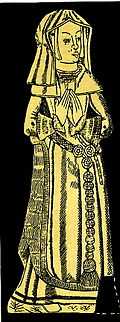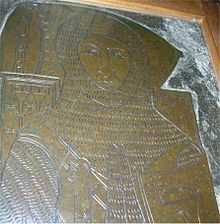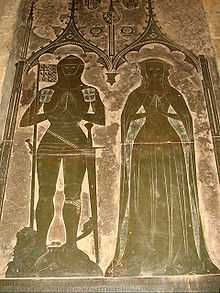Monumental brass
Monumental brass is a species of engraved sepulchral memorial which in the early part of the 13th century began to partially take the place of three-dimensional monuments and effigies carved in stone or wood. Made of hard latten or sheet brass, let into the pavement, and thus forming no obstruction in the space required for the services of the church, they speedily came into general use, and continued to be a favourite style of sepulchral memorial for three centuries.[1]
Monumental brasses in Europe
Besides their great value as historical monuments, monumental brasses are interesting as authentic contemporary evidence of the varieties of armour and costume, or the peculiarities of palaeography and heraldic designs, and they are often the only authoritative records of the intricate details of family history. Although the intrinsic value of the metal has unfortunately contributed to the wholesale spoliation of these interesting monuments, they are still found in remarkable profusion in England, and they were at one time equally common in France, Germany and the Low Countries. In France, however, those that survived the troubles of the 16th century were totally swept away during the Reign of Terror, and almost the only evidence of their existence is now supplied by the collection of drawings bequeathed by Gough to the Bodleian Library.[1]
Only two or three examples, and these of late date, are known in Scotland, among which are the memorials of Alexander Cockburn (1564) at Ormiston; of the regent Murray (1569) in the collegiate church of St Giles, Edinburgh; and of the Minto family (1605) in the south aisle of the nave of Glasgow Cathedral.[1] The Earl of Moray had been assassinated, and his monumental brass carries the Moray arms and figures representing Religion and Justice.[2]
The fine memorials of the royal house of Saxony in the cathedrals of Meissen and Freiberg are the most artistic and striking brasses in Germany. Among the 13th-century examples existing in German churches are the full-length memorials of Yso von Welpe, Prince-Bishop of Verden (1231), and of Bernard, bishop of Paderborn (1340). Many fine Flemish specimens exist in Belgium, especially at Bruges.[1]

Monumental brasses in England
The majority of extant memorial brasses are now found in England, where it is calculated that there may be about 4,000 still remaining in various churches. They are most abundant in the eastern counties, and this fact has been frequently adduced in support of the opinion that they were of Flemish manufacture. But at the time sepulchral brasses were most often fashioned, the eastern counties of England were a center of commercial activity and wealth, and there are numerous engraved memorials of civilians and prosperous merchants in the churches of Ipswich, Norwich, Lynn and Lincoln. Flemish brasses can be found in England, but they are not common, and they are readily distinguished from English workmanship. The Flemish examples have the figures engraved in the centre of a large plate, the background filled in with diapered or scroll work, and the inscription placed round the edge of the plate. The English examples have the figures cut out to the outline and inserted in corresponding cavities in the slab, the darker colour of the stone serving as a background. This is not an invariable distinction, however, as figure-brasses of Flemish origin are found both at Bruges and in England. But the character of the engraving is constant, the Flemish work being more florid in design, the lines shallower, and the broad lines cut with a chisel-pointed tool instead of the lozenge-shaped burin.[1]
The brass of Robert Hallum, bishop of Salisbury, the envoy of King Henry V to the council of Constance, who died and was interred there in 1416, precisely resembles the brasses of England in the details which distinguish them from styles elsewhere in Europe. Scarcely any of the brasses which now exist in England can be confidently referred to the first half of the 13th century, though several undoubted examples of this period are on record. The full-sized brass of Sir John d'Aubernon at Stoke d'Abernon in Surrey (c. 1277) has the decorations of the shield filled in with a species of enamel. Other examples of this occur, and the probability is that, in most cases, the lines of the engraving were filled with colouring matter, though brass would scarcely bear the heat requisite to fuse the ordinary enamels. A well-known 13th century example is that of Sir Roger de Trumpington (c. 1290), who accompanied Prince Edward in his expedition to Palestine and is represented cross-legged. About half a dozen examples of this stylistic feature are known.[1]
The 14th century brasses are much more numerous, and present a remarkable variety in their details. The finest specimen is that of Nicholas Lord Burnell (1315) in the church of Acton Burnell, Shropshire. In the 15th century the design and execution of monumental brasses had attained their highest excellence. The beautiful brass of Thomas de Beauchamp, 12th Earl of Warwick (d. 1401), and his wife Margaret, which formerly covered the tomb in St Mary’s church, Warwick, is a striking example. One of the best specimens of plate armour is that of Sir Robert Stantoun (1458) in Castle Donington church, Leicestershire, and one of the finest existing brasses of ecclesiastics is that of Thomas de la Mare, Abbot of St Albans Abbey from 1349 to 1396.[1]

It is only in the 16th century that the engraved representations become portraits. Previous to that period the features were invariably represented conventionally, though sometimes personal peculiarities were added. A large number of brasses in England are palimpsests, the back of an ancient brass having been engraved for the more recent memorial. Thus a brass commemorative of Margaret Bulstrode (1540) at Hedgerley, on being removed from its position, was discovered to have been previously the memorial of Thomas Totyngton, abbot of St Edmundsbury (1312). The abbey was only surrendered to Henry VIII in 1539, so that before the year was out the work of spoliation had begun, and the abbot’s brass had been removed and re-engraved to Margaret Bulstrode. These ancient brasses were often stolen and re-erected after being engraved on the reverse, as at Berkhampstead, because until the establishment of a manufactory at Esher by a German artisan in 1649, all sheet brass had to be imported from other countries on the European mainland.[1]
English brasses by county
- Monumental brasses of Bedfordshire
- Monumental brasses of Berkshire
- Monumental brasses of Cambridgeshire
- Monumental brasses of Cheshire
- Monumental brasses of Cornwall
- Monumental brasses of Cumberland
- Monumental brasses of Derbyshire
- Monumental brasses of Devonshire
- Monumental brasses of Dorset
- Monumental brasses of Co. Durham
- Monumental brasses of Essex
- Monumental brasses of Gloucestershire
- Monumental brasses of Hampshire
- Monumental brasses of Herefordshire
- Monumental brasses of Hertfordshire
- Monumental brasses of Huntingdonshire
- Monumental brasses of Kent
- Monumental brasses of Lancashire
- Monumental brasses of Leicestershire
- Monumental brasses of Lincolnshire
- Monumental brasses of Middlesex
- Monumental brasses of Norfolk
- Monumental brasses of Northamptonshire
- Monumental brasses of Northumberland
- Monumental brasses of Nottinghamshire
- Monumental brasses of Oxfordshire
- Monumental brasses of Rutland
- Monumental brasses of Shropshire
- Monumental brasses of Somerset
- Monumental brasses of Staffordshire
- Monumental brasses of Suffolk
- Monumental brasses of Surrey
- Monumental brasses of Sussex
- Monumental brasses of Warwickshire
- Monumental brasses of Westmorland
- Monumental brasses of Wight, Isle of
- Monumental brasses of Wiltshire
- Monumental brasses of Worcestershire
- Monumental brasses of Yorkshire
Nineteenth century brasses

There was a revival of interest in monumental brasses in the Victorian era. Victorian brasses can be seen at Truro Cathedral (Archbishop Benson), Oscott College, Birmingham (Bishop John Milner), St. Nicolas', Guildford (Rev. W. S. Sanders), and All Saints, Boyne Hill, Maidenhead (Rev. Gresley and Canon Drummond).
See also
Sources
- Dane Love. Scottish Kirkyards (1989 ed.). Robert Hale Pub.;. p. 223. ISBN 0-7090-3667-1.
Bibliography
- Waller, John Green & Waller, Lionel. Drawings of Monumental Brasses and Incised Slabs, 1837-44. (A standard reference work)
- Incised Monumental Memorials of the Middle Ages (1847) and The Monumental Brasses of England, a series of Engravings upon Wood, with brief descriptive notices (1849).
- Cambridge Camden Society, Illustrations of Monumental Brasses of Great Britain (1840–46).
- Herbert Haines, A Manual of Monumental Brasses, comprising an introduction to the Study of these Memorials, and a list of those remaining in the British Isles, 2 volumes (1861, reprinted 1970).
- John Page-Phillips, Macklin's Monumental Brasses (1969), a revised version of Macklin's original The Brasses of England (1907).
- Oxford University Brass Rubbing Society, Oxford Journal of Monumental Brasses, vol. I (1897-9); vol. II (1900), and Oxford Portfolio of Monumental Brasses (1898–1901).
- Mill Stephenson, A List of Monumental Brasses in the British Isles (1926) with an Appendix by M.S. Giuseppi and Ralph Griffin (1938).
- Victoria and Albert Museum, Catalogue of Rubbings of Brasses and Incised Slabs, 2nd Edition (1929, reprinted 1969).
- Sally Badham and Malcolm Norris, Early Incised Slabs and Brasses (1999)
- Davis, C.T., The Monumental Brasses of Gloucestershire, London, 1899
- Boutell, Charles, Monumental Brasses and Slabs, 1847
- Boutell, Charles, The monumental Brasses of England, 1849
- Dunkin, E.H.W. The Monumental Brasses of Cornwall, 1882
References
- ↑ 1.0 1.1 1.2 1.3 1.4 1.5 1.6 1.7
 One or more of the preceding sentences incorporates text from a publication now in the public domain: Chisholm, Hugh, ed. (1911). "Monumental brass". Encyclopædia Britannica 4 (11th ed.). Cambridge University Press. p. 434.
One or more of the preceding sentences incorporates text from a publication now in the public domain: Chisholm, Hugh, ed. (1911). "Monumental brass". Encyclopædia Britannica 4 (11th ed.). Cambridge University Press. p. 434. - ↑ Love (1989). Page 34 and 35
External references
| Wikimedia Commons has media related to Monumental brasses. |
| Wikimedia Commons has media related to Brass rubbings in the United Kingdom. |
